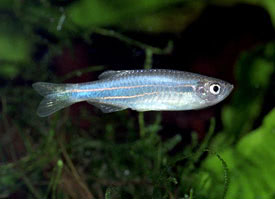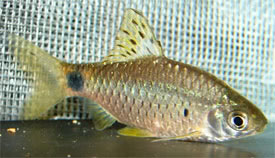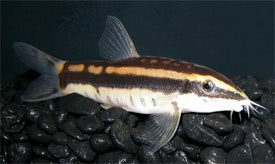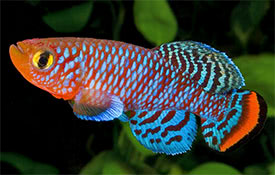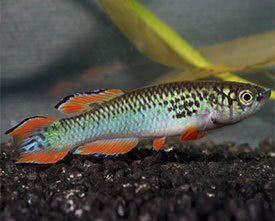
 Magyarul / Hungarian
Magyarul / Hungarian




- Scientific name: Danio margaritatus
- Synonyms: Celestichthys margaritatus (Roberts; 2007), Microrasbora sp. galaxy, Galaxy rasbora
- Common name: Celestial Pearl Danio
- Group: Cyprinids
- Distribution: Asia; Myanmar (Burma), northern Thailand.
- Size: 2 cm
- Biotope: These fish live in a very small area near Hopong east of Inle Lake, at an altitude of over 1000 m, and some populations live in the Salween river. The typical habitat of the fish is small and shallow permanently-flooded grassland ponds with only around 30cm deep water, and dense aquatic vegetation.
- Social behavior: A very peaceful and shy shoaling danio. It is best to keep them alone or with other small species in a community aquarium. It is not uncommon to see nipped fins within a group, but in a larger group the aggression is spread between individuals and the fish are more bolder.
- Diet: Omnivorous; in nature it eats small invertebrates and algae. In the aquarium it will accept dried foods of a suitable size, and small frozen and live foods too.
- Breeding: Quite easy
- Tank: Minimum 30 litres
- Population: 8-10 fish for 40 litres
- Decoration: Use a densely-planted aquarium with dark colored substrate. Some floating plants can be a useful addition. Use gentle filtration, an air-powered sponge filter is adequate.
- Temperature: 20-26 °C
- pH: 6.5-7.5
- Hardness: 5.0-15.0 dGH
- Lifespan: 3-3 years
On males all fins, except the pectoral fins, show two parallel black lines with a bright red area in between, while on the tail fin, this pattern is present on each lobe. The females are a little bit more washed out and grow a little larger than males. In addition a female in reproductive age can be recognized by a black anal spot.
Like many small cyprinids this species is an egg-scatterer that exhibits no parental care after laying the eggs. In a heavily-planted aquarium where there are both males and females, a relatively small numbers of fry may start to appear without any human intervention, but if you want to increase the yield of fry a separate breeding tank should be used. During courtship the flanks of the male brighten and darken. Similarly to other Danio species the breeding pair or group can be added to the breeding tank in the evening. The aquarium should be densely planted with fine leaved aquatic plants, such as Java moss. The female will release the mildly adhesive eggs among the plants. The number of the eggs usually around 30. After spawning the parents should be removed from the aquarium, because they will eat the eggs, and the females also need a recovery period before spawning again. Incubation is temperature-dependant, and usually takes around 72 hours with the fry free-swimming 3-4 days later. The adult color pattern starts to appear from week 12 onwards. The tiny fry can be fed with microscopic foods or liquid fry foods.
https://www.fishbase.ca/summary/Celestichthys-margaritatus.html
https://www.seriouslyfish.com/species/celestichthys-margaritatus
https://en.wikipedia.org/wiki/Danio_margaritatus



















